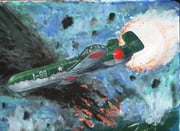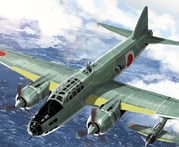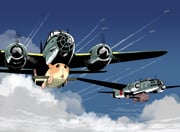g4m
The Mitsubishi G4M, also known as 一式陸上攻撃機 (Isshiki Rikujou Kougeki-ki, lit. "type 1 land-based attack aircraft") or its abbreviated name, 一式陸攻 (Isshiki Rikukou or Isshiki Rikkou), was a twin engined bomber for the Imperial Japanese Navy in World War II.
Its Allied codename is Betty. It is the successor aircraft to Mitsubishi's own G3M and the de-facto predecessor of the Yokosuka P1Y Ginga bomber.
The airplane can be easily distinguished by its cigar-shaped fuselage, hence the nickname "flying cigar", albeit also attributed to its fragility to anti-air: like the A6M Zero and the Ki-43 Hayabusa, the early versions of the aircraft achieved their performance (especially range) at the expense of armor and self-sealing fuel tanks, making it vulnerable to enemy machine gun hits. This weakness is increased if the aircraft is used as a torpedo bomber due to its large size. This was what claimed Yamamoto Isoroku's life in mid-1943 when he was shot down by US fighters in the Solomon Islands (see post #3810385).
It was designed by Honjou Kirou [本庄 季郎] and entered combat for first time in June 1941.
See also
- Mitsubishi G3M
- List of Airplanes





